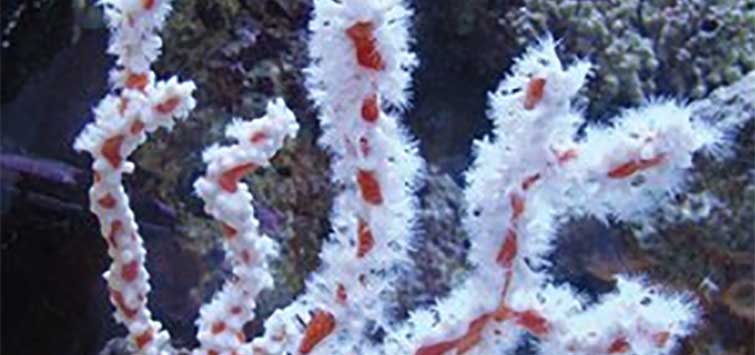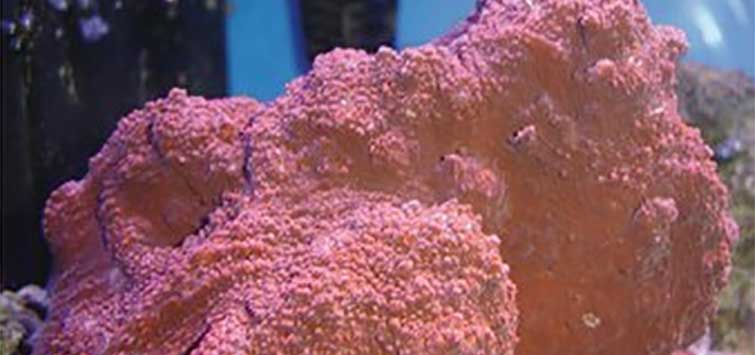Cliona vastifica
Common Names: Boring sponge, red ball sponge
Phylum: Porifera (Sponges)
Class: N/A
Order: Hadromerida
Family: Clionaidae
Range: Mainly found in western Pacific waters, e.g., Indonesia, Philippines, and Australia, yet also found in other areas, e.g., Panama, Egypt, Jordan, France, Norway, and Portugal
Natural Environment: Species in this genus are mostly called “boring sponges” due to their ability to attach themselves to calcium carbonate substrates, such as live rock, shells, and coral skeletons.
Water Requirements: Calcium 380 to 430 mg/l, alkalinity 2.5 to 3.0 meq/l, pH 8.1 to 8.2, specific gravity 1.024 to 1.026, Mg approx. 1300 mg/l, nitrate >15 mg/l, phosphate < .015 mg/l, and a temperature range of 72° to 83°F.
Captive Care
Water and Filtration
This is a filter-feeding animal that requires excellent water movement. As with most sponges, they should be kept in systems that are normally somewhat nutrient rich or those that can be fed heavily without creating growths of unwanted algae. Trace elements and other liquid-based products made specially to enhance the nutrition of filter-feeding animals should also be used per manufacturer instructions.
Furthermore, the outer surface of the sponge should either be vacuumed or have its surface cleaned with a turkey baster to blow off any accumulating detritus or sand particles. Without a clean surface, the sponge is unable to draw nutrients into its body—essentially a collection of cells forming a cavity, which the filtered water exits from. Even though it prefers nutrient-rich surroundings, it will not tolerate algae growth, as that blocks the uptake of nutrients.
Feeding
Keep in mind that, although sponges are multicellular creatures like most other animals, they do not possess nervous, digestive, or excretory systems, and most feed by filtering suspended bacteria and fine detritus. Strong water movement is necessary for almost all sponges, not only for carrying food to these sessile creatures but also to carry waste/unused matter away. In fact, a sponge the size of a baseball can filter 50 gallons of water per hour!
Reproduction
Sponges have both sexual and asexual components in their lifecycles. For the sexual component, each sponge has both male and female reproductive capabilities. For asexual reproduction in an aquarium setting, cutting a piece from the healthy tissue and simply relocating it to another suitable area can form a new colony.
Bagging Specimens
Bear in mind that the new specimen should not be exposed to air during this procedure (nor at any time), as that may kill it. In fact, when purchasing new specimens, they should be bagged under water, not simply lifted out of the water. Nor should any air be in the bag, as it may become trapped in the animal’s tissue while being transported and lead to its early demise.
Damage
Furthermore, even though they are not too sensitive to temperature changes, sudden changes in salinity may have drastic effects. Should this sponge contain any gray or white tissue, which is no doubt dying or dead, beware, as the entire specimen could deteriorate quite quickly. Nevertheless, if not overly damaged and still desired, it’s possible to cut such dead areas out without harming adjacent tissue (the sponge, again, should be kept underwater during the process).
Long-Term Maintenance
Generally, almost all sponges are difficult to maintain long term, and this beautiful species is no different. It should be kept in systems designed to meet its needs, not simply as a colorful addition to a new reef tank—or even that of a thriving reef system if its nutritional needs cannot be met. Their long-term survival rate in closed systems is highly questionable, and if its requirements cannot be fulfilled, it’s better left in the wild or, at least, the dealer’s system. Sponges are especially poor selections for newly established aquaria, as the necessary organic matter and/or bacterial content are not yet adequate for their long-term survival.

.png?h=595&iar=0&w=2781&hash=5FD5E69473BCC22199FBFA2FB71B6033)



